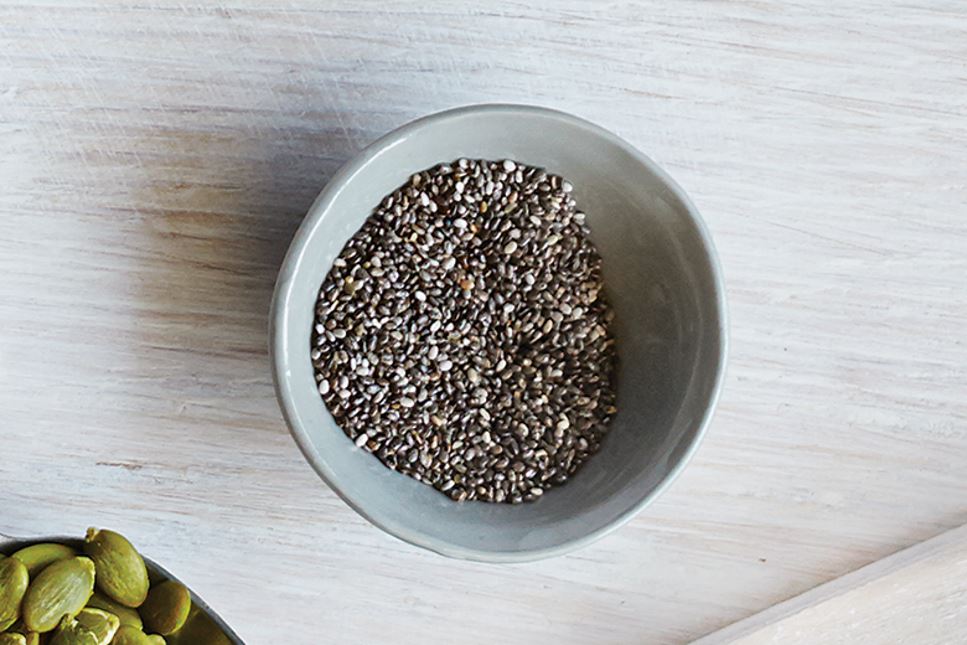It’s hard not to notice this once-ignored member of the mint family — chia seeds are all the rage. From beverages to baked goods, these tiny black and white seeds from the Salvia hispanica plant have a long history. Chia seeds are believed to have been a staple in the Aztec diet.
Nutritionally Speaking
Chia is one powerful little seed. A 2-tablespoon (1-ounce) serving contains around 140 calories and 9 grams of fat, along with a whopping 10 grams of fiber, 5 grams of protein and 14% of the daily value for calcium. It’s also surprisingly packed with alpha-linolenic acid omega-3s — 5 grams per ounce, more than you’ll find in whole flaxseed.
Chia seeds’ claims range from controlling hunger to promoting heart health and reducing blood sugar levels, but evidence supporting this “superfood’s” reputation doesn’t live up to all of the hype — at least not so far.
Although rare, people who are sensitive to mustard, sesame seeds, oregano or thyme may also react to chia. Those taking blood thinners or medications for heart conditions should speak with their doctors before eating chia seeds.
Growing
Chia seeds are native to Mexico and South America. They flower into purple flowers and lose their petals before the seeds can be harvested.
Availability
Once only available in health food stores, you now can find chia seeds in most grocery stores and online.
Purchasing
Chia seeds, unlike flax, don’t have to be ground in order to get the health benefits and can be eaten whole. You’re most likely to find chia as seeds, but chia powder — which is simply finely milled chia seeds — is available, too, or you can grind the seeds yourself at home.
You can buy black or white chia seeds; there is no nutritional difference between the colors.
Storing
Chia seeds should be kept in a cool, dry place. Since they can go rancid or mold, it’s important to keep them sealed, preferably in an airtight container, to prevent them from absorbing moisture. Many people store chia seeds in their fridge. Whole chia seeds tend to last longer than ground. Properly stored, chia seeds will stay fresh for about 18 months.
Soaked chia seeds should be covered and kept in the fridge. They will keep about five to seven days before spoiling.
Preparing
Most people use chia seeds combined with liquid, so they swell. Soaked seeds will swell and take on a chewy texture like tapioca pudding. Dry chia seeds pair well with both sweet and savory foods, adding more crunch and texture than flavor.
Using
Like flaxseeds, chia seeds have a mild, nutty flavor, but unlike flaxseeds, they can be eaten whole as well as ground. Add either form to smoothies, juices, oatmeal or yogurt. They also can be used to thicken sauces and salad dressings.
Chia seeds can be used as a substitute for eggs in baked goods, which is particularly useful for vegans or those with egg allergies. Simply mix one part chia seeds to three parts water. About 1 tablespoon of this gel equals one large egg. Chia’s ability to gel also makes the seeds a fine substitute for pectin in jam.
Chia seeds are an integral ingredient in the Mexican and Central American favorite drink chia fresca, in which the seeds are mixed into lime or lemon juice with added sweetener. The suspended seeds make an impressive drink presentation.
This information originally appeared in Food & Nutrition Magazine®, published by the Academy of Nutrition and Dietetics.
References
Find a Nutrition Expert
Looking for credible nutrition information and recommendations? The Academy of Nutrition and Dietetics' network of credentialed food and nutrition practitioners are ready to help!

